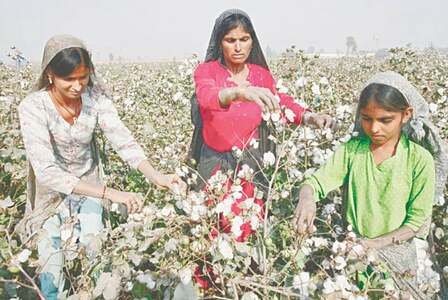LAHORE: A staggering fall of up to 60 per cent in the production of cotton both in Punjab and Sindh by Aug 31 has rung alarm bells in the textile sector, which is forced to meet its lint requirements from the foreign markets at the cost of precious foreign exchange.
A difference of over 0.3 million bales in the crop figures released by Punjab’s Crop Reporting Service (CRS) and Pakistan Cotton Ginners Association (PCGA) confuses the industry about its future procurement strategy.
The data shared by the PCGA showed that around 1.226m bales reached ginning factories across the country by Aug 31, registering a steep decline of 60pc compared to 3.04m bales produced in the same period last year.
This significant shortfall in the cotton output is being attributed to various issues. These included a decline in the early sowing trend, prolonged heatwave during June and July leading to fruit shedding, heavy rains in August, whitefly and pink bollworm attacks, shrinking crop acreage, no announcement of intervention price by the government, cotton market manipulation by vested interest, decreasing crop profitability, and a lack of government support for research and development.
Industry confused due to stark difference in output numbers
The PCGA report says that Sindh has produced 0.773m bales this year against last year’s 1.972m bales for the same period, a drop of 61pc in the production. Likewise, Punjab registered a 58pc fall as only 0.453m bales reached the gates of ginning factories against last year’s 1.068m bales.
Punjab CRS claims that the province has harvested 0.759m bales, over 30pc less than the previous year’s production.
CRS Director-General Dr Abdul Qayyum argues that his agency calculates production at the farm level based on the size of cotton bolls and the picking ratio. He claims that the weight of the boll has been recorded at 3.34g this season against 3.29g last year, a 1.52pc increase in weight.
According to him, cotton has so far been picked from 46pc of the crop area, while last year 63pc of the crop had been picked by this time.
Central Cotton Research Institute’s Sajid Mahmood claims that the continuous fall in cotton output and yield since 2016 is because of a lack of funds for R&D to develop new crop varieties capable of withstanding climate change impact. He laments that the lack of support from the textile industry and the government for the Pakistan Central Cotton Committee has hindered R&D, hurting the textile industry and the national economy.
A cotton ginner claims that under-invoicing or undocumented business by some ginning units, apparently because of the imposition of heavy taxes on the sector, is a key reason behind the ‘unusual’ decline in the lint production and the difference between the PCGA and CRS data.
Cotton Ginners Forum chairman Ihsanul Haq says that cotton stakeholders are drawing a parallel between the PCGA-CRS crop data variation and the Feb 8 general election dispute of Forms 45 and 47.
He says that the recent heavy rains damaged the crop not only quantity-wise but also quality-wise, making the textile millers turn towards lint imports as they have so far purchased 1.171m bales against 2.615m bales in the same period last year.
Karachi Cotton Brokers Forum chairman Naseem Usman claims that Pakistani spinners have so far signed import deals for 1.6m bales, while negotiations are going on for more import agreements given the reported shortfall in the local cotton output and quality.
Published in Dawn, September 4th, 2024

















































